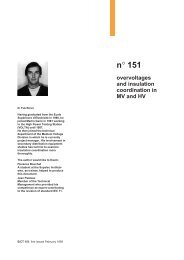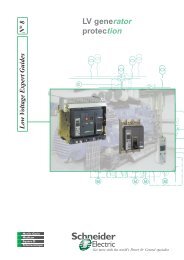Ground Fault Protection - engineering site - Schneider Electric
Ground Fault Protection - engineering site - Schneider Electric
Ground Fault Protection - engineering site - Schneider Electric
- No tags were found...
You also want an ePaper? Increase the reach of your titles
YUMPU automatically turns print PDFs into web optimized ePapers that Google loves.
In shortThe IEC 60 364 standard defines 3 typesof earthing systems (ES):b TN systemb TT systemb IT system.ES characteristics are:b an insulation fault has varyingconsequences depending on the systemused:v fault that is dangerous or notdangerous for personsv strong or very weak fault current.b if the fault is dangerous, it must bequickly eliminatedb the PE is a conductor.The TT system combined with ResidualCurrent Devices (RCD) reduces the riskof fire1.2. Safety and installation standardsDefined by installation standards, basic principles for the protection ofpersons against the risk of electrical shocks are:b the earthing of exposed conductive parts of equipment and electrical loadsb the equipotentiality of simultaneously accessible exposed conductive parts thattend to eliminate touch voltagetb the automatic breaking of electric power supply in case of voltage or dangerouscurrents caused by a live insulation fault current.1.2.1. The IEC 60 364 standardSince 1997, IEC 364 is identified by a no.: 60 XXX, but its content is exactly thesame.1.2.1.1. Earthing systems (ES)The IEC 60 364 standard, in § 3-31 and 4-41, has defined and developed 3 maintypes of earthing systems (ES). The philosophy of the IEC standard is to take intoaccount the touch voltage (Uc) value resulting from an insulation fault in each of thesystems.1/ TN-C and TN-S systemsb characteristics:v an insulation fault creates a dangerous touch voltage: it must be instantaneouslyeliminatedv the insulation fault can be compared to a phase-neutral short-circuit(Id = a few kA)v fault current return is carried out by a PE conductor. For this reason, the fault loopimpedance value is perfectly controlled.<strong>Protection</strong> of persons against indirect contact is thus ensured by Short-Circuit<strong>Protection</strong> Devices (SCPD). If the impedance is too great and does not allow thefault current to incite protection devices, it may be necessary to use Residual CurrentDevices (RCD) with low sensitivity (LS >1 A).<strong>Protection</strong> of goods is not “naturally” ensured.The insulation fault current is strong.Stray currents (not dangerous) may flow due to a low PE - neutral transformerimpedance.In a TN-S system, the installation of RCDs allows for risks to be reduced:bmaterial destruction (RCD up to 30 A)fire (RCD at 300 mA).bBut when these risks do exist, it is recommended (even required) to use a TTsystem.DB117213DB117214Diagram 1a - "TN-S system"Diagrame 1b - "TN-C system"

















